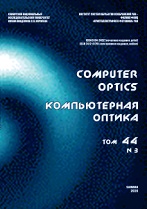|
This article is cited in 6 scientific papers (total in 6 papers)
OPTO-IT
High numerical aperture metalens to generate an energy backflow
V. V. Kotlyarab, S. S. Stafeevba, L. O'Faolaincd, M. V. Kotlyarc
a Samara National Research University, 443086, Samara, Russia, Moskovskoye Shosse 34
b IPSI RAS – Branch of the FSRC "Crystallography and Photonics" RAS,
443001, Samara, Russia, Molodogvardeyskaya 151
c Centre for Advanced Photonics and Process Analysis, Cork Institute of Technology, Cork T12 P928, Ireland
d Tyndall National Institute, Cork T12R5CP, Ireland
Abstract:
Using electronic beam lithography and reactive ion beam etching, a metalens is manufactured in a thin layer of amorphous silicon of a 130-nm depth, a 30-$\mu$m diameter, and a 633-nm focal length (equal to the illumination wavelength). The metalens is composed of 16 sectored subwavelength binary gratings with a 220-nm period. The uniqueness of this metalens is that when illuminated by left-handed circularly polarized light, it is capable of generating a left-handed circularly polarized vortex beam with a topological charge of 2, generating a second-order cylindrical vector beam when illuminated by linearly polarized light. Both for linear and circular incident polarization, an energy backflow is found to be generated in the vicinity of the tight focus. Transverse intensity distributions measured with a scanning near-field optical microscope near the focus of the metalens are in qualitative agreement with the intensity distributions calculated by the FDTD method. This confirms that a backward energy flow takes place at the focus of the metalens. A metalens generating an energy backflow near its focus is fabricated and characterized for the first time.
Keywords:
metalens, subwavelength grating, energy backflow.
Received: 21.04.2020
Accepted: 29.06.2020
Citation:
V. V. Kotlyar, S. S. Stafeev, L. O'Faolain, M. V. Kotlyar, “High numerical aperture metalens to generate an energy backflow”, Computer Optics, 44:5 (2020), 691–698
Linking options:
https://www.mathnet.ru/eng/co837 https://www.mathnet.ru/eng/co/v44/i5/p691
|

| Statistics & downloads: |
| Abstract page: | 145 | | Full-text PDF : | 46 | | References: | 26 |
|




 Contact us:
Contact us: Terms of Use
Terms of Use
 Registration to the website
Registration to the website Logotypes
Logotypes








 Citation in format
Citation in format 
